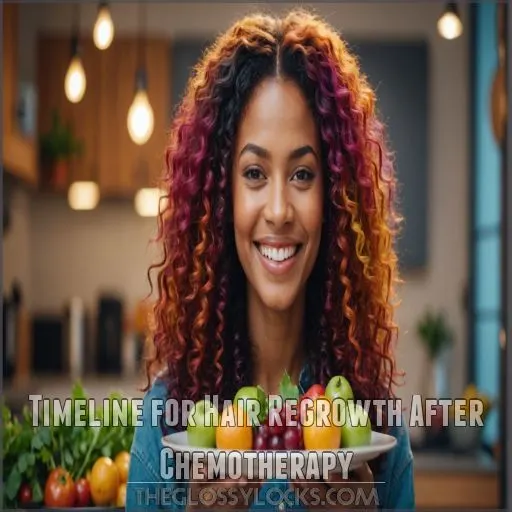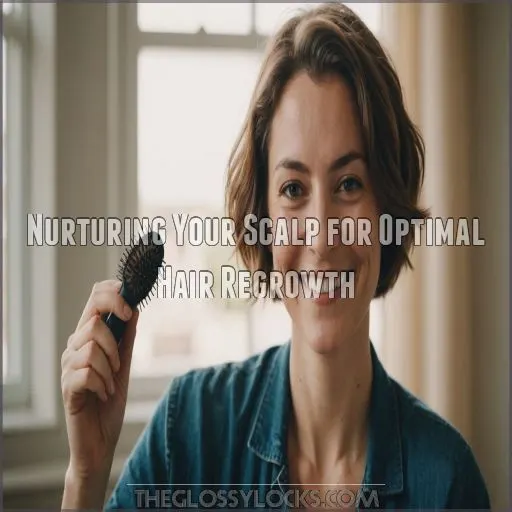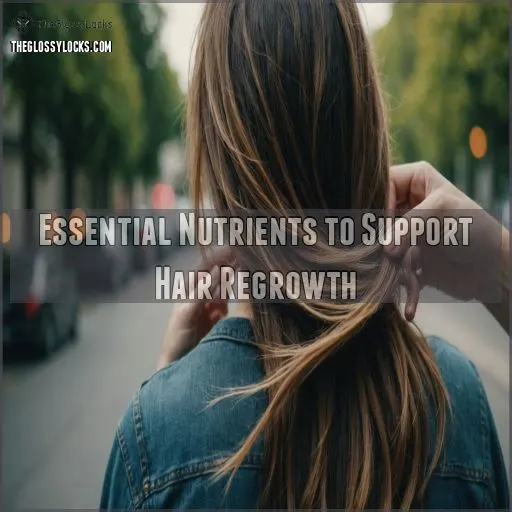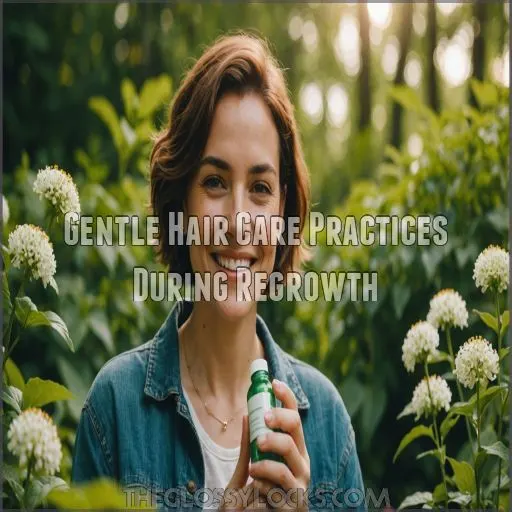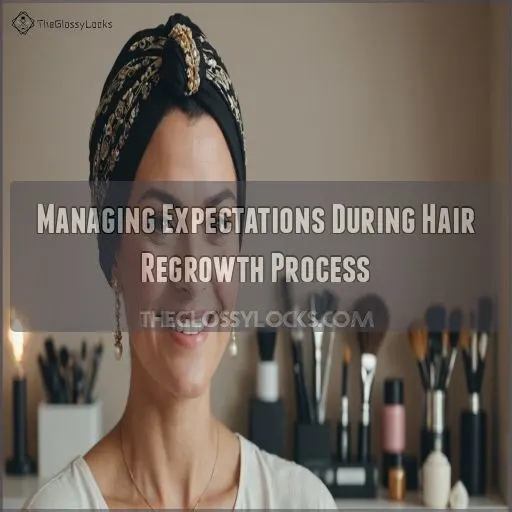This site is supported by our readers. We may earn a commission, at no cost to you, if you purchase through links.
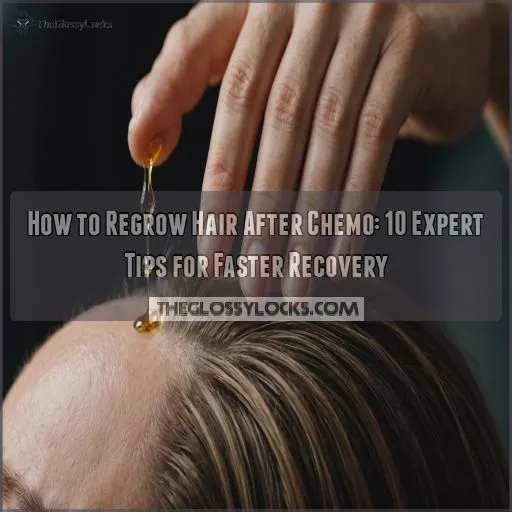 Regrowing hair after chemo can feel like you’re nurturing a tiny garden on your scalp. Don’t worry, those fuzzy peach fuzz sprouts are a sign of good things to come!
Regrowing hair after chemo can feel like you’re nurturing a tiny garden on your scalp. Don’t worry, those fuzzy peach fuzz sprouts are a sign of good things to come!
To help your hair regrow faster, focus on nourishing your body from the inside out. Load up on protein-rich foods, vitamins, and omega-3s.
Treat your scalp like royalty with gentle care and soothing massages. You might even want to try minoxidil to give those follicles a wake-up call.
Remember, patience is key – your luscious locks will return, but they might surprise you with a new texture or even some ‘chemo curls.’
Curious about the timeline and what to expect along the way?
Table Of Contents
- Key Takeaways
- Timeline for Hair Regrowth After Chemotherapy
- Nurturing Your Scalp for Optimal Hair Regrowth
- Essential Nutrients to Support Hair Regrowth
- Gentle Hair Care Practices During Regrowth
- Dealing With Changes in Hair Texture
- Medications and Treatments to Boost Regrowth
- Managing Expectations During Hair Regrowth Process
- Natural Remedies to Promote Hair Regrowth
- Styling Options During Different Regrowth Stages
- When to Consult a Healthcare Professional
- Frequently Asked Questions (FAQs)
- What helps hair grow back faster after chemo?
- Can hair loss from chemo be reversed?
- What food is good for hair growth after chemo?
- How to remove chemo hair stubble?
- Can stress affect hair regrowth after chemotherapy?
- Are there specific hairstyles to avoid during regrowth?
- How does age impact hair regrowth post-chemo?
- Can certain medications interfere with hair regrowth?
- Is it safe to color regrowing hair?
- Conclusion
Key Takeaways
- You’re on a hair-raising journey, so pamper your scalp like it’s royalty. Gentle massages, sulfate-free shampoos, and a "no heat" policy are your new best friends. Think of your scalp as a delicate garden – nurture it, and you’ll soon see those fuzzy sprouts turning into a lush mane.
- Feed your follicles from the inside out. Load up on protein-rich foods, vitamins, and omega-3s like they’re going out of style. Your body’s been through a lot, so give it the building blocks it needs to stage a hair comeback. Remember, you are what you eat – so eat like you want fabulous hair!
- Patience isn’t just a virtue; it’s your secret weapon. Your hair’s on its own timeline, and it might throw you some curveballs along the way. Embrace those "chemo curls" or surprise color changes – they’re just part of your unique hair story. Rome wasn’t built in a day, and neither is your new ‘do.
- Don’t go it alone – your healthcare team is your backstage crew in this hair regrowth show. If something seems off or you’re itching (literally) for advice, give them a shout. They’ve seen it all and can help you navigate any bumps in the road to luscious locks.
Timeline for Hair Regrowth After Chemotherapy
After braving chemotherapy, you’re likely excited to see your hair make a comeback.
Understanding the timeline for hair regrowth can help you set realistic expectations and give you something to look forward to as you recover.
Initial Signs of Hair Regrowth
After the storm of chemo, you’ll be anxious for signs of new growth.
Keep an eye out for a soft fuzz, like peach skin, appearing on your scalp.
You might feel a tingling sensation as follicles wake up.
Don’t be surprised if your new hair has a mind of its own – "chemo curls" are a common plot twist in this hair-raising adventure.
Embrace the change; your crowning glory is making a comeback!
Stages of Hair Regrowth
Following chemotherapy, your hair regrowth journey unfolds in stages.
You’ll likely notice soft, fuzzy hair (think baby duck!) appearing first.
As weeks pass, this peach fuzz gives way to more substantial growth.
Your hair may come in patchy or uneven at first, but don’t fret—it’s all part of the process.
By the six-month mark, you’ll typically see a full head of hair emerging.
Factors Affecting Regrowth Speed
During your hair regrowth journey, several factors can influence how quickly your locks return. Your age and genetics play a role, as does your overall health. Proper nutrition and stress management can give your follicles a boost, while certain medications might slow things down.
Don’t be surprised if your regrowth speed differs from others – everyone’s experience is unique.
Remember, patience is key!
Expected Timeline for Full Regrowth
In spite of hair regrowth variations, you’ll typically see full regrowth within 6-12 months post-chemo.
Your journey might be quicker or slower, depending on factors like treatment type and overall health.
Remember, patience is key!
Some folks see peach fuzz as early as 3-4 weeks after treatment, while others wait a bit longer.
Don’t fret if your hair color or texture changes—it’s all part of the process.
Nurturing Your Scalp for Optimal Hair Regrowth
After chemotherapy, your scalp needs some extra TLC to encourage healthy hair regrowth, and using natural ingredients for hair can help. Think of your scalp as a garden – with the right care, it’ll flourish! Here are four ways to nurture your scalp:
- Give yourself a gentle scalp massage daily to boost circulation.
- Cleanse with a mild, sulfate-free shampoo to avoid irritation.
- Protect your sensitive scalp from the sun with a cozy head covering.
- Try soothing scalp treatments like aloe vera or chamomile tea rinses.
Remember, patience is key – your hair’s on its own unique journey. While you’re waiting for those first sprouts, why not have some fun with different head coverings? You might even discover a new style you love! And don’t forget, programs like "Look Good Feel Better" can offer great tips and support during this time. Your scalp’s working hard, so treat it kindly!
Essential Nutrients to Support Hair Regrowth
After chemotherapy, your hair needs all the help it can get to grow back strong and healthy.
Let’s explore the essential nutrients that’ll give your locks the boost they need, from protein powerhouses to key vitamins – think of it as a nutritional spa day for your scalp!
Protein-Rich Foods for Hair Growth
Your scalp’s ready for action, but it needs fuel!
Think of protein as your hair’s building blocks.
You’ll want to load up on lean meats, fish, eggs, and legumes.
These powerhouses give your follicles the amino acids they crave.
Vegetarian? No worries!
Quinoa, nuts, and tofu are your new best friends.
Remember, a protein-packed plate is like sending your hair to boot camp – it’ll come back stronger than ever!
Vitamins and Minerals for Hair Health
While protein fuels hair growth, vitamins and minerals play a starring role too.
Think of them as your hair’s backstage crew, working tirelessly to support regrowth.
Biotin, the hair health superstar, teams up with iron to combat deficiency-related hair loss.
Zinc steps in as the unsung hero, promoting cell division for faster growth.
Don’t forget vitamin D – it’s not just for bones, it’s your scalp’s secret weapon too!
Omega-3 Fatty Acids and Hair Regrowth
The mighty omega-3s are your hair’s best friend during regrowth.
These fatty acids nourish follicles, reduce inflammation, and promote healthy scalp circulation.
You’ll find them swimming in fatty fish like salmon, walnuts, and flaxseeds.
Can’t stomach fish? No worries! Fish oil supplements can be a great alternative.
Remember, consistency is key – make omega-3s a regular part of your diet for luscious locks.
Hydration and Its Impact on Hair
Staying well-hydrated is like watering a garden for your hair.
Proper water intake nourishes your scalp, promoting healthier hair growth, just like staying hydrated after quitting alcohol.
You’ll notice improved hair texture and shine when you’re hydrated.
Aim for 8 glasses of water daily, and consider herbal teas too.
Remember, hydration benefits extend beyond your locks – it’s great for your overall health.
So, raise a glass to your future mane!
Gentle Hair Care Practices During Regrowth
As your hair begins to regrow after chemo, it’s really important to treat it with extra care.
Let’s explore some gentle hair care practices that’ll help nurture your new growth and boost your confidence during this exciting phase of recovery, like using Ayurvedic hair care tips to promote healthy hair growth. Ayurvedic hair care tips.
Choosing the Right Shampoo and Conditioner
Now that you’ve fueled your body with hair-friendly nutrients, let’s talk shampoo and conditioner.
Your newly sprouting locks need extra TLC.
Look for sulfate-free options that won’t strip your scalp’s natural oils.
Scan ingredient lists for gentle cleansers and moisturizers suited to your hair type.
Remember, what worked before chemo mightn’t be ideal now.
Don’t be afraid to experiment – your scalp will thank you!
Proper Washing and Drying Techniques
Your scalp’s sensitivity requires a gentle touch during hair regrowth.
Wash your hair with lukewarm water, as hot water can strip away natural oils.
Use your fingertips to massage the scalp softly, avoiding harsh scrubbing.
When drying, pat your hair gently with a soft microfiber towel – no vigorous rubbing!
For brushing, opt for a wide-toothed comb to detangle without tugging.
Remember, treat your new hair like a delicate flower.
Avoiding Heat Styling and Harsh Chemicals
While gentle washing is key, it’s equally important to steer clear of heat styling and harsh chemicals.
Think of your new hair as a delicate seedling – it needs nurturing, not scorching!
Embrace heat-free styling methods like air-drying or soft rollers.
Opt for natural, chemical-free hair products to pamper your scalp.
Remember, patience is your best friend during this regrowth journey.
Your locks will thank you for the TLC!
Scalp Massage for Stimulating Growth
After giving harsh chemicals the boot, let’s get hands-on with your scalp!
A gentle massage can work wonders for hair regrowth.
It’s like giving your follicles a pep talk, boosting blood flow and awakening sleepy strands.
Try using your fingertips or a soft brush in circular motions.
Start with 5 minutes daily, gradually increasing as it feels comfortable.
Remember, patience is key – your scalp’s on a journey too!
Dealing With Changes in Hair Texture
As your hair regrows after chemo, you might notice some surprising changes in texture.
Whether it’s curlier, straighter, or a different color than before, we’ll show you how to adapt your hair care routine and embrace your new locks.
Common Texture Changes After Chemotherapy
Brace yourself for a hair transformation! Chemo can leave you with locks that seem to have a mind of their own. You might notice your once-straight hair now sports curls, or vice versa.
The color and thickness may surprise you too.
Don’t be alarmed if your scalp feels more sensitive than before.
Remember, these changes are often temporary, and your hair will continue to evolve as it grows back.
Adapting Hair Care for New Textures
Now that your hair’s growing back, you might notice it feels different. Don’t worry – this is normal! Your new locks might be curlier, straighter, or even a different color.
It’s time to adapt your hair care routine to these changes.
- Experiment with leave-in conditioners for added moisture
- Try sulfate-free shampoos to prevent dryness
- Invest in a silk pillowcase to reduce friction
Remember, patience is key as you discover what works best for your new hair.
Styling Tips for Different Hair Textures
Your post-chemo hair might surprise you with its new texture.
Whether it’s curly, straight, fine, thick, or wavy, embrace the change!
For curly locks, try leave-in conditioners and finger-coiling.
Straight hair? Volumizing products can add body.
Fine strands benefit from lightweight styling creams, while thick hair loves deep conditioning treatments.
Wavy hair? Scrunch in some sea salt spray for beachy vibes.
Remember, your new texture is uniquely yours – rock it!
When to Seek Professional Hair Care
While adapting to new hair textures can be tricky, sometimes it’s best to call in the pros.
Consider seeking professional hair care when:
- Your hair feels unmanageable or brittle
- You’re experiencing persistent scalp issues
- You’re ready for a style refresh but feel unsure
A skilled stylist can work wonders, offering personalized advice and treatments to nurture your newly grown locks.
Remember, there’s no shame in asking for help – your hair deserves some TLC after its journey!
Medications and Treatments to Boost Regrowth
You’re not alone if you’re hoping to speed up hair regrowth after chemo.
Let’s explore some medications and treatments that might give your hair follicles a much-needed boost, helping you reclaim your luscious locks faster.
Minoxidil for Hair Regrowth After Chemo
Hair texture changes can be challenging, but there’s hope for faster regrowth. Enter minoxidil, a popular over-the-counter treatment that might give your locks a boost. Let’s break down what you need to know:
| Aspect | Details |
|---|---|
| Dosage | 2% or 5% solution |
| Application | Twice daily to scalp |
| Effectiveness | May speed up regrowth |
| Side effects | Scalp irritation, dryness |
Remember, patience is key – think of your hair as a garden you’re nurturing back to life. Consult your doctor before starting any new treatments.
Prescription Options for Hair Regrowth
After trying over-the-counter options, you might consider prescription medications to boost hair regrowth.
These powerful allies in your hair recovery journey can be game-changers.
- Finasteride (Propecia)
- Spironolactone
- Dutasteride
- Oral minoxidil
Remember, these aren’t magic potions, but they can give your follicles the extra push they need. Always consult your oncologist before starting any new medication to make sure it’s safe for your specific situation.
Scalp Cooling Systems During Chemotherapy
You’ve probably heard about scalp cooling systems to prevent hair loss during chemo. Let’s break down the pros and cons:
| Aspect | Pros | Cons |
|---|---|---|
| Effectiveness | Onion juice, which is said to improve hair health, can reduce hair loss | Not 100% effective |
| Comfort | Cooling sensation | Can be cold and uncomfortable |
| Duration | Used during treatment | Extends infusion time |
| Cost | May be covered by insurance | Can be expensive |
| Availability | Available in many centers | Not offered everywhere |
While not perfect, these systems offer hope for maintaining your locks during treatment.
Low-Level Laser Therapy for Hair Growth
The gentle glow of low-level laser therapy (LLLT) might be your hair’s new best friend.
This non-invasive treatment uses red light to stimulate follicles and promote growth.
While LLLT’s effectiveness varies, some studies show promising results.
It’s generally safe and can be done at home, though devices aren’t cheap.
Remember, patience is key – LLLT isn’t a magic wand, but it could give your locks a fighting chance.
Managing Expectations During Hair Regrowth Process
Regrowing your hair after chemo can be an emotional rollercoaster, filled with ups and downs.
You’ll need patience and a positive attitude as you navigate this journey, but remember that each new strand is a small victory worth celebrating.
Emotional Aspects of Hair Regrowth
Hair regrowth after chemo can be an emotional rollercoaster.
One day, you’re thrilled to spot fuzzy new growth; the next, you’re frustrated by its slow pace.
It’s normal to feel a mix of excitement, impatience, and anxiety.
Your changing appearance may impact your body image and self-esteem.
Remember, everyone’s journey is unique.
Lean on loved ones or join support groups to share your feelings and find encouragement.
Coping Strategies for Slow Regrowth
Facing slow regrowth? Don’t lose heart! Remember, patience is your best friend during this journey.
Try joining support groups to connect with others who’ve walked in your shoes.
Practice positive self-talk, reminding yourself that this is temporary.
Explore wig options for a confidence boost, and consider hair growth supplements after consulting your doctor.
Above all, be kind to yourself – you’re stronger than you know!
Celebrating Milestones in Hair Regrowth
While waiting for your locks to return, it’s time to celebrate every little victory!
Keep a hair growth diary to track your progress.
Snap weekly pics to see the changes over time.
Join support groups where you can share your regrowth joy with others who get it.
Remember, each new strand is a milestone worth cheering for.
You’ve got this!
Natural Remedies to Promote Hair Regrowth
You might be interested in trying natural remedies like those found in natural hair dyes to speed up your hair regrowth after chemo.
While there’s no magic solution, some gentle, natural approaches may help nourish your scalp and support healthy hair growth as your body recovers.
Essential Oils for Scalp Health
Now that you’ve managed your expectations, let’s explore a natural approach to boost your hair regrowth journey. Essential oils can be a game-changer for scalp health.
- Rosemary oil: Stimulates circulation
- Peppermint oil: Promotes hair growth by boosting circulation to the scalp, just like moringa for hair growth
- Lavender oil: Soothes the scalp
When using these oils, remember: a little goes a long way. Mix a few drops with a carrier oil and gently massage into your scalp. It’s like giving your follicles a spa day!
Herbal Supplements for Hair Growth
If you’re thinking about herbal supplements for hair growth, you’ve got options. Many swear by saw palmetto, ginseng, and horsetail extract.
But hold your horses! Before diving in, chat with your doctor. Some herbs can interact with medications or have side effects.
Remember, what works for your neighbor mightn’t work for you. Start with small doses and be patient – your hair’s on a journey, not a race!
Aloe Vera and Its Benefits
Aloe vera, nature’s soothing superhero, can be your scalp’s new best friend during hair regrowth.
This wonder plant isn’t just for sunburns; it’s packed with vitamins and minerals that nourish your scalp and promote healthy hair growth.
You can apply pure aloe gel directly to your scalp or whip up a DIY hair mask.
It’s like giving your follicles a revitalizing green smoothie!
Scalp Exfoliation Techniques
Gently exfoliating your scalp can kickstart hair regrowth after chemo. It’s like giving your scalp a fresh start!
Here are three techniques to try:
- Use a soft-bristled brush for dry scalp massage
- Apply a DIY sugar scrub with coconut oil
- Try a store-bought scalp exfoliator with natural ingredients
Remember, less is more. Start with once a week and listen to your scalp. You’re the captain of this hair-growing ship!
Styling Options During Different Regrowth Stages
As your hair begins to regrow after chemotherapy, you’ll face new styling challenges at each stage.
Let’s explore some practical and creative options to help you feel confident and comfortable during your hair regrowth journey, from choosing the right headwear to deciding when it’s time for that first post-chemo haircut.
Headwear Choices for Early Regrowth
Your early hair regrowth journey doesn’t have to be a fashion nightmare.
Embrace stylish scarves that double as sun protection and boost your confidence.
Experiment with lightweight, breathable fabrics for wig comfort during those warmer days.
Don’t shy away from bold patterns or vibrant colors – they’re your canvas for self-expression.
Remember, head coverings aren’t just practical; they’re an opportunity to showcase your unique style and resilience.
Short Hairstyles for Growing Hair
As your hair starts to grow back, short hairstyles are your new best friends.
Embrace a pixie cut or a textured crop to make the most of your growing locks.
These styles are chic and promote healthy growth by reducing stress on delicate strands.
Don’t be afraid to experiment with different looks – it’s your hair’s time to shine!
Techniques for Disguising Uneven Growth
As your hair sprouts back, it might resemble a patchy garden. Don’t fret! Hair toppers can be your secret weapon, adding volume and coverage where needed.
Scarves and headbands work wonders too, concealing uneven growth while adding flair.
Strategic placement of hair clips can redirect attention from sparse areas. Styling products like mousse or texturizing spray can give the illusion of fullness, making you feel like a hair-raising superhero!
When to Consider Your First Haircut
Moving on from disguising uneven growth, let’s talk about that exciting first haircut. Timing is everything when it comes to your post-chemo trim.
Consider these factors:
- Hair length: Is it long enough to style?
- Growth stage: Has it reached a consistent pattern?
- Hair health: Does it feel strong enough?
- Style preference: Ready for a new look?
- Scalp sensitivity: Has it calmed down?
Remember, there’s no rush. Your hair’s on its own journey, so listen to what it’s telling you. When you’re ready, that first snip will feel like a fresh start!
When to Consult a Healthcare Professional
While regrowing your hair after chemo is usually a smooth process, there are times when you’ll want to check in with your healthcare team.
Keep an eye out for unusual changes or persistent scalp issues, and don’t hesitate to reach out if something seems off – your doctors are there to help you through every step of your recovery journey.
Signs of Abnormal Hair Regrowth
Your hair’s regrowth journey after chemo can be a rollercoaster of emotions. While everyone’s experience is unique, certain signs may indicate it’s time to check in with your healthcare team.
Keep an eye out for these potential red flags:
| Warning Sign | What to Look For | When to Consult |
|---|---|---|
| Hair thinning | Noticeable patches | After 3 months |
| Patchy growth | Uneven distribution | Persistent unevenness |
| Color changes | Unexpected hues | Dramatic shifts |
| Texture differences | Unusually coarse or fine | Extreme changes |
| Excessive shedding | More than usual | Ongoing for weeks |
These signs may indicate that you need to consult with your healthcare team for proper guidance and care during your regrowth journey.
Addressing Persistent Scalp Issues
While your hair’s making a comeback, don’t ignore persistent scalp issues.
If you’re battling dryness, itching, flaking, redness, or pain that won’t quit, it’s time to call in the pros.
These pesky problems can throw a wrench in your hair regrowth journey.
Remember, your scalp’s been through the wringer, so it might need some extra TLC.
Don’t suffer in silence – your healthcare team’s got your back!
Evaluating the Need for Additional Treatment
After addressing persistent scalp issues, it’s time to think about if you need extra help with hair regrowth. Sometimes, despite your best efforts, hair might not grow back as expected. Here’s when to think about additional treatments:
- Hair growth is much slower than anticipated
- Bald patches remain after several months
- New hair is extremely thin or brittle
Don’t throw in the towel just yet! There are options available that might give your hair the boost it needs.
Discussing Concerns With Your Oncologist
Don’t hesitate to voice your hair regrowth concerns to your oncologist. They’re your ally in this journey. Share any worries about slow growth, unusual textures, or scalp issues.
It’s not just vanity – your oncologist can spot potential problems early.
Remember, no question is too small regarding your health and well-being. They’ve seen it all, so speak up and get the support you need.
Frequently Asked Questions (FAQs)
What helps hair grow back faster after chemo?
You can’t rush hair regrowth, but you can support it.
Be gentle with your scalp, eat a balanced diet, and consider biotin supplements.
Patience is key—your locks will return, often with a mind of their own!
Can hair loss from chemo be reversed?
Miraculously, chemo hair loss isn’t permanent!
Your luscious locks will stage a comeback.
Time‘s your best ally, but gentle care, a healthy diet, and patience are key.
Within months, you’ll be rocking your renewed ‘do!
What food is good for hair growth after chemo?
Focus on nutrient-rich foods like leafy greens, lean proteins, and whole grains.
Boost intake of biotin-rich eggs, nuts, and sweet potatoes.
Omega-3 fatty acids from fish can also support healthy hair growth.
Stay hydrated!
How to remove chemo hair stubble?
Imagine this: you’re a lawn mower, but your grass is stubborn chemo stubble.
Gently shave or wax the area, or let it fall out naturally.
Be patient and kind to your skin during this process.
It’s temporary, promise!
Can stress affect hair regrowth after chemotherapy?
Yes, stress can affect hair regrowth after chemo.
Your body’s recovering, and stress hormones may slow things down.
Try to relax – deep breaths, meditation, or a good laugh can help.
Your locks will bounce back!
Are there specific hairstyles to avoid during regrowth?
During regrowth, steer clear of tight hairstyles like ponytails or braids.
They can stress delicate new hair.
You’ll want to treat your locks like a newborn – with gentle care and lots of love!
How does age impact hair regrowth post-chemo?
Age can influence hair regrowth after chemo.
You’ll likely see slower growth and potentially thinner hair as you get older.
Don’t worry, though – most folks still experience regrowth, it just might take a bit longer.
Can certain medications interfere with hair regrowth?
Picture your hair as a delicate garden.
Just as certain chemicals can stunt plant growth, some medications may interfere with hair regrowth.
You’ll want to chat with your doctor about any meds you’re taking to make sure they’re not hindering your luscious locks’ comeback.
Is it safe to color regrowing hair?
You’ll want to hold off on coloring your regrowing hair for a bit.
It’s best to wait until your locks are stronger and healthier – usually about 6 months after chemo.
Your patience will pay off!
Conclusion
Regrowing hair after chemo is like tending a garden – it takes patience, care, and the right nutrients.
Remember, your journey is unique, and your hair may surprise you with new textures or curls.
By following these expert tips, you’re nurturing your scalp and giving your hair the best chance to thrive.
Celebrate each milestone, from peach fuzz to your first trim.
With time and dedication, you’ll see your locks flourish.
Stay positive, and don’t hesitate to seek support when needed.
Your hair’s comeback story is just beginning!

